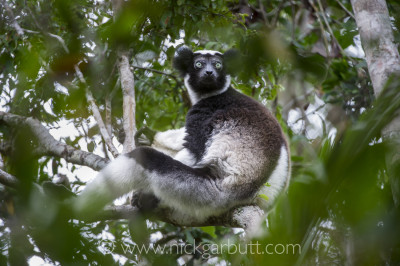More Madagascar Blues

Immeasurably more valuable than sapphires, an indri in the rain forest canopy
The recent discovery of sapphires and other precious gems, and the subsequent explosion in illegal mining operations is further threatening the besieged rainforests of Madagascar and the numerous already endangered species that live there, most specifically endearing lemurs like the indri.
Madagascar’s latest ‘sapphire rush’ has seen an influx of around 40,000 illegal workers descend on a remote part of north east Madagascar, an area where some of the largest remaining tracts of the island’s priceless rainforest remain. Madagascar has already lost 90% of its original forest cover and the illicit mining operations that entail clearing the forest, before excavations begin is further impinging on this.
Madagascar’s native fauna (and flora) is over 90% endemic (found no where else) and is almost entirely forest dependent: once the forest disappears these species disappear too. The rainforest of the north east are home to countless species that are endangered (because of habitat loss and the illegal bush meat trade), the lemurs being the most well-known. The indri is the largest of the remaining lemurs and is famed for its cute teddy bear looks and haunting wailing song. It is only found in the rainforests of the north east and the sapphire mining is in the heart of one of the species last remaining strongholds.
Indris, other lemurs and all Madagascar’s amazing unique wildlife are priceless: way more valuable than a few bits of silly blue stone, used for pointless human adornment and vanity.
Don’t buy* sapphires and other gems to fuel the market.
Further information
BBC – Why buying sapphires could kill this lemur
BBC – Into Madagascar’s valley of sapphires
* Even sapphires and gems that are bought from reputable may have come via the illegal trade in Madagascar that is often funnelled through dealers in Sri Lanka and Thailand.
